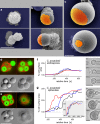Mechanistic Understanding of Single-Cell Behavior is Essential for Transformative Advances in Biomedicine
- PMID: 30258315
- PMCID: PMC6153630
Mechanistic Understanding of Single-Cell Behavior is Essential for Transformative Advances in Biomedicine
Abstract
Most current efforts to advance medical technology proceed along one of two tracks. The first is dedicated to the improvement of clinical tasks through the incremental refinement of medical instruments. The second comprises engineering endeavors to support basic science studies that often only remotely relate to human medicine. Here we survey emerging research approaches that aim to populate the sprawling frontier between these tracks. We focus on interdisciplinary single-live-cell techniques that have overcome limitations of traditional biological methods to successfully address vital questions about medically relevant cellular behavior. Most of the presented case studies are based on the controlled manipulation of nonadherent human immune cells using one or more micropipettes. The included studies have (i) examined one-on-one encounters of immune cells with real or model pathogens, (ii) assessed the physiological role of the expandable surface area of immune cells, and (iii) started to dissect the spatiotemporal organization of signaling processes within these cells. The unique aptitude of such single-live-cell studies to fill conspicuous gaps in our quantitative understanding of medically relevant cause-effect relationships provides a sound basis for new insights that will inform and drive future biomedical innovation.
Keywords: adhesion; calcium; chemotaxis; host-pathogen; immune cell; micropipette; neutrophil; phagocytosis; signaling; single-cell.
Figures


References
-
- Mestas J, Hughes CC. Of mice and not men: differences between mouse and human immunology. J Immunol. 2004;172(5):2731–8. - PubMed
Publication types
MeSH terms
Substances
Grants and funding
LinkOut - more resources
Full Text Sources
